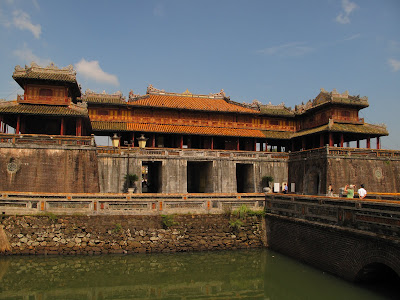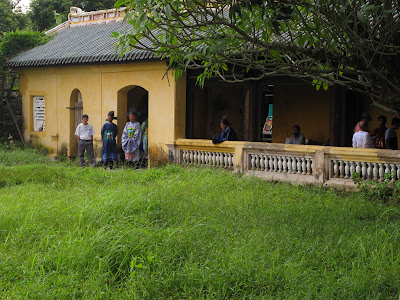 From Hanoi we flew to the central Vietnamese city of Hue (pronounced hway). Hue was made the capital of a united Vietnamese kingdom in 1802 when the first emperor of the Nguyen Dynasty defeated a county-wide rebellion and seized the city with the backing of the French. Hue has its own cusine, influenced by both the imperial court and the local environment.
From Hanoi we flew to the central Vietnamese city of Hue (pronounced hway). Hue was made the capital of a united Vietnamese kingdom in 1802 when the first emperor of the Nguyen Dynasty defeated a county-wide rebellion and seized the city with the backing of the French. Hue has its own cusine, influenced by both the imperial court and the local environment. For breakfast one morning, we enjoyed com hen: freshwater river snail, sliced star fruit, mint, peanut, chili, banana flower, fried pork skin and rice noodles. The river snail is the part that is very special to Hue and it was great.
For breakfast one morning, we enjoyed com hen: freshwater river snail, sliced star fruit, mint, peanut, chili, banana flower, fried pork skin and rice noodles. The river snail is the part that is very special to Hue and it was great. Here we have one of the Nguyen emperors with his advisors. Many Nguyen emperors were deposed over the course of the 19th century by an overbearing French interference in local affairs. This intimidating diplomacy was the beginning of imperialism in Indochina that eventually led to the direct control by France of the country in the 1870's. The Nguyen Dynasty held on essentially as puppets until 1945 with the end of World War II when the last emperor abdicated and the country was launched into the first Indochina war with France for independence.
Here we have one of the Nguyen emperors with his advisors. Many Nguyen emperors were deposed over the course of the 19th century by an overbearing French interference in local affairs. This intimidating diplomacy was the beginning of imperialism in Indochina that eventually led to the direct control by France of the country in the 1870's. The Nguyen Dynasty held on essentially as puppets until 1945 with the end of World War II when the last emperor abdicated and the country was launched into the first Indochina war with France for independence. When the Nguyens took power at the beginning of the 19th century, ending years of civil strife, rebellion, and a battle for power with the Trinh lords based in Hanoi, they built an impressive imperial citadel in Hue to represent their new status. The design was influenced by the Forbidden City in Beijing as well as French military architecture and took years of work by local artisians and craftspeople to complete. Although the world was entering the modern era, Nguyen Vietnam (with influence from France and Qing China) was a grand and glorious court of splendor that harked back to earlier times.
When the Nguyens took power at the beginning of the 19th century, ending years of civil strife, rebellion, and a battle for power with the Trinh lords based in Hanoi, they built an impressive imperial citadel in Hue to represent their new status. The design was influenced by the Forbidden City in Beijing as well as French military architecture and took years of work by local artisians and craftspeople to complete. Although the world was entering the modern era, Nguyen Vietnam (with influence from France and Qing China) was a grand and glorious court of splendor that harked back to earlier times. Unfortunately Hue, like much of central Vietnam, was right at the epicenter of both the French Indochina war and the second Indochina war with the United States. The imperial city was mostly destroyed by Vietnamese mortor shells and US napalm when Hue was occupied by North Vietnamese forces during the Tet Offensive.
Unfortunately Hue, like much of central Vietnam, was right at the epicenter of both the French Indochina war and the second Indochina war with the United States. The imperial city was mostly destroyed by Vietnamese mortor shells and US napalm when Hue was occupied by North Vietnamese forces during the Tet Offensive.  A model shows the layout and proportions of the imperial city. 80% of these buildings were destroyed during the war.
A model shows the layout and proportions of the imperial city. 80% of these buildings were destroyed during the war.
UNESCO is working with local authorities to restore the imperial enclosure, piece by painstaking piece. The result is a fascinating mix of ruins, partial ruins, empty parkland, and glitteringly restored or rebuilt structures spread over several square acres.







 A Vietnamese period piece was being shot on the grounds as we walked around.
A Vietnamese period piece was being shot on the grounds as we walked around. Just outside town is the Thien Mu Pagoda. Originally founded in 1601 when Hue was merely a provincial town, the current pagoda and nearby temple were built in 1844 by the Nguyen emperor Theiu Tri. After the partition of Vietnam (post-French Indochina war) Thien Mu became a nexus of political opposition against the policies of anti-Buddhist, pro-Catholic, US-backed South Vietnamese president, Ngo Dinh Diem. It was from this temple in 1963 that a monk named Thich Quang Duc left for Saigon where he set himself on fire and burned himself to death in protest. Images of his self-immolation were spread around the world.
Just outside town is the Thien Mu Pagoda. Originally founded in 1601 when Hue was merely a provincial town, the current pagoda and nearby temple were built in 1844 by the Nguyen emperor Theiu Tri. After the partition of Vietnam (post-French Indochina war) Thien Mu became a nexus of political opposition against the policies of anti-Buddhist, pro-Catholic, US-backed South Vietnamese president, Ngo Dinh Diem. It was from this temple in 1963 that a monk named Thich Quang Duc left for Saigon where he set himself on fire and burned himself to death in protest. Images of his self-immolation were spread around the world.The ghosts and darkness of this country's wars are much more tangible in central Vietnam than in the north. We also visited a prison site where US and South Vietnamese forces held and tortured North Vietnamese and Viet Cong (the civilian guerrilla wariors fighting for the north) in the 1960's and 70's. The current heavy-handed propoganda at the site leaves nothing to the imagination, but of course fails to mention the postwar purges and "re-education" the victorious communists doled out to southern Vietnamese leaders and intellectuals after 1975. The bottom line is that the Vietnam War (like all war) was brutal and horrifying. Despite the optimism and positive changes in Vietnamese society in recent years, the wounds of humanitarian crimes carried out by all sides (not least of all the United States) are still very, very evident here.
 The Perfume River, home of the delicious river snail.
The Perfume River, home of the delicious river snail.


 We came upon the Mauria Springs Thermal Resort just in time, and pulled over to take a dip in their
We came upon the Mauria Springs Thermal Resort just in time, and pulled over to take a dip in their 





 South of Westport the fog rolled in and hid the sun again. This didn't keep the drive from being one of the most dramatic I have ever experienced. By the time we made it to the boarders of Paparoa National Park, we were speechless: rugged cliffs, seemingly tropical rain forest, black sand beaches, 100 foot waterfalls, bright orange flowers. It looked like something Dr. Seuss would dream up for a children's book.
South of Westport the fog rolled in and hid the sun again. This didn't keep the drive from being one of the most dramatic I have ever experienced. By the time we made it to the boarders of Paparoa National Park, we were speechless: rugged cliffs, seemingly tropical rain forest, black sand beaches, 100 foot waterfalls, bright orange flowers. It looked like something Dr. Seuss would dream up for a children's book.






